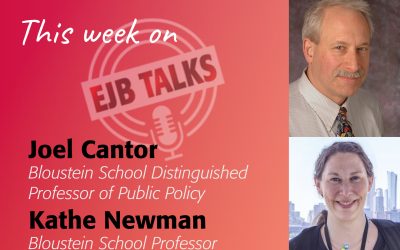Stuart Shapiro welcomes Professor James DeFilippis on this riveting episode of EJBTalks, where they discuss Dr. DeFilippis’ recent work on the role of immigration and organizational politics in local economic development. He speaks in-depth about how Amazon’s HQ2 plan for Long Island City and Western Queens epitomized the use of local tax incentives to attract mega corporations, often contrary to the wishes of the community’s residents. Dr. Defilippis also discusses how culturally diverse places like Queens have particularly fascinating organizational politics with alliances that are often unpredictable to the outside observer.
Stuart Shapiro
Welcome to EJB Talks. I’m Stuart Shapiro, the Associate Dean of Faculty at the Bloustein School, and the purpose of this podcast is to talk with my colleagues and our alumni about policy, planning and health, the interaction between these issues and how they affect people in New Jersey, the United States and the world.
Today, I’m very happy to have Professor James DeFilippis from our nationally-ranked urban planning program. Welcome to the podcast, James.
James DeFilippis
Thank you for having me, Stuart. It’s good to be here.
Stuart Shapiro
Absolutely. So your recent work has focused a lot on two issues, local economic development, and immigration. Since our audience is some planning, but some not planning folks, can you explain to the audience the connection between these issues and what they might think of as urban planning?
James DeFilippis
With local economic development, that’s been a part of what planners do, really since the 1970s and 1980s. Basically, you had a coincidence in time of deindustrialization, happening at the same time that the federal government was deciding it was going to stop doing revenue sharing, and stop funneling money through HUD directly and to city governments. And so cities became very quickly involved in “how can we plan to have our economy be okay.”
Immigration is, I think, a central part of what makes up and shapes the future of our cities, right? And if planning is ultimately about people getting together to rationally decide how to transform the places and spaces of their city to make them better–which is how I usually just think about planning–then immigration is a central part of it. Who is populating our cities? And so it becomes very much part of our narrative, although in interesting kinds of ways.
Stuart Shapiro
And nowhere is that more true than in New York City and in Queens, certainly where you’ve done your work. Can you tell our listeners the story–which I think is a fascinating one and obviously, we could spend an hour on it… but doing it quickly–of Amazon trying to open a facility in Queens, and how that went down?
James DeFilippis
Sure. So Amazon, as your listeners probably remember, announced that they were taking bids for their HQ2. And this was through 2018. And basically, it was a standard “what can we get from local governments in terms of subsidies?” Very typical kind of gouged…and this, again, is a story, right? Because a company like that can locate anywhere. Municipal government has a jurisdiction that is not physically mobile. And so they start out inherently unequally. It’s also, just to be clear, terrible local economic development policy to be doing tax subsidies for anybody. I mean, it’s not a good long-term plan. But that’s a separate thing.
They announced two winners, one in Northern Virginia, and the other in New York City in Long Island City in western Queens. The broader local economic development point is that the whole thing was a sham. They decided they were going to put their offices where they were always going to put them, in DC… well, outside of DC… because of all of the kind of public work that they’re doing in government contracts that they have, particularly with, with DHS. And in New York, because of the importance of media.
The reaction very quickly from the community, and I mean very quickly, was to mobilize against it. You know, even when it was a whisper and it looked like they were going to announce it, you had a coalition of people getting together. A South Asian community group in Jackson Heights, a couple of neighborhoods over from them. And then, when they did announce it, they had a full city-wide meeting of groups against it. And a city-wide immigrant organizing group, which has its main offices in Jackson Heights as well. And that is when you had a whole set of different actors coming together. You know, the politics alone were super complicated. And I think we’re going to spend a little more time on that. But the way the story ends is, after a few months, let’s see they announced this in November of 2018. By the time you get to February Valentine’s Day of 2019, a few months later, they announced they’re going to pull out.
They had reached a deal–and for the podcast, I have to be cautious about my language–they had reached a deal with some of the organized labor that was opposed. But they withdrew not just from the deal, but from the whole plan. And the postscript is that of course, Amazon wasn’t coming to New York anyway. If you read Crain’s New York Business, which everyone should… kidding, but I do (laughing)… you know, you can keep up with the amount of office space they’re leasing in New York. That the reason why they walked away was that even at the $3.2 billion subsidy, stretched out over 15 years, what is that really to a company with annual revenues of $160 billion and double digit growth rates? What exactly is a $3 billion dollar subsidy?
Stuart Shapiro
They have the luxury of treating that like chump change.
James DeFilippis
Yes.
Stuart Shapiro
Yeah. So the opposition, let’s focus on that because I know that that’s sort of where a lot of your interest lies. Why did it materialize? And why was it successful?
James DeFilippis
A few things. It materialized from a bunch of different places. That part of western Queens has been gentrifying very rapidly. They have been sweeping away manufacturing… they swept away manufacturing through a set of rezonings in the first decade of the 21st century. And that got rid of a whole industrial ecology. We lost our manufacturing in New York City, not because of globalization, but because of land use policy. What manufacturers always say is, they cannot keep their land in New York. It’s not that they’re losing to competition from China or South Asia, it’s that they just cannot keep their land.
And so they rezone and put up condo towers. And if you go along the 7 train to the eastern end of that, you have the center for Hong Kong and Taiwanese and mainland Chinese finance capital. And so, all of the neighborhoods in between, are basically like the two fat ends of a dumbbell. And all of the neighborhoods in between are like the rod. And in that rod you have anywhere from 60 to 80% of the population being foreign-born. It’s not poor. These are not poor neighborhoods, any of them. But they’re not wealthy. These are very working-class Queens, right? Like, this is as if Archie Bunker were Ecuadorian, he would be like that. That’s sort of the community, right?
Stuart Shapiro
The show would play very differently in that case. (((laughing)))
James DeFilippis
(((Laughing))) Yes, totally different. But anyway, so there’s a natural sort of opposition to this kind of mega-development in the context of displacement that is already occurring. You fold into that the fact that in these neighborhoods, AWS is one of the principal contractors. Amazon with their cloud work and their tracing work is one of the principal technological means that the Department of Homeland Security utilizes to target immigrants who are either visa overstayers or unauthorized entrances. Undocumented immigrants from either avenue to being undocumented.
And so in these immigrant neighborhoods, it was a very real issue that you were having, that the tech is destroying their community. And while this is happening, you’re having a national scale ramping up of deportations, detentions very purposeful and very targeted. You know, you’ve always had workplace raids at poultry factories. Things like this, you know, and that’s a whole other conversation that we can have about the absurdity of American immigration policy. But under the Trump administration, you were also getting a lot more military RVs rolling up into residential neighborhoods, going to public schools.
Stuart Shapiro
Right. Knocking on doors. Exactly.
James DeFilippis
And, it was in these neighborhoods. So the organizers were playing that up a lot, because they were greatly affected by that, and what that would mean. And essentially, you had real estate pressure, and then you had Amazon. And then you had, of course, organized labor. And so Amazon has the remarkable ability to make Walmart look like a good employer. There is an incredible hostility, particularly among the Teamsters and the retail workers’ unions, because of the conditions in Amazon warehousing, and short-haul trucking, and last mile. All of the logistics of that once you go from the warehouse. And so that confluence of neighborhood groups, immigrant rights groups, and labor was enough.
Why did they succeed? Truthfully, this is what I was saying earlier. Amazon left the deal because they don’t need the money. They’re coming to New York, they’re just coming quietly, right? They walked away from a deal because if they had reached a deal, that would have had a much more significant kind of precedent-setting dynamic for their work. Because a deal that they might be reaching with the RWDSU, and with the Teamsters.. sorry, that’s Retail, Wholesale, and Department Store Workers Union, the RWDSU. The retail workers, basically. If they reach a deal with them about the conditions in their warehouses, it’s not just in New York, right? It’s not just a kind of large distribution site in Staten Island. It becomes “well, what are they doing for their massive distribution sites in Maryland?” And everywhere. That’s probably a lot more than $3 billion.
Stuart Shapiro
Better to come in quietly and not with any commitments.
James DeFilippis
Exactly.
Stuart Shapiro
That you have to follow through on.
James DeFilippis
That’s right. And they’re leasing at Hudson Yards, they’re getting the public subsidy anyway.
Stuart Shapiro
Right.
James DeFilippis
They’re just getting it… the public subsidy is baked into that development project already, you know?
Stuart Shapiro
So you talk a lot about organization politics. I mean, I’ve done podcasts on electoral politics here. But you’re talking about something different. I was wondering if you could sort of expound on that?
James DeFilippis
Sure. It’s funny, we all recognize in the world of politics, that you get things done when you have a constituency that is able to mobilize pressure, either through money or people. And that constituency is sufficient enough, is powerful enough to overwhelm any opposition constituency, that can be mobilized around people or money on the other side. That is the standard, and the elected just sort of go along with that. You bring the elected with you when you have either the people or money. It’s sort the old community organizer kind of language, that there are two things, there’s organized people and there’s organized money. And in communities, right, you don’t have the organized money. So you have to have the latter…Saul Alinsky, the Chicago community organizer, sort of one of his mantras.
But in any case, what you have…we don’t take that fundamental understanding and apply it to the way things are actually going to play out in any particular kind of context in quite the same way when we’re talking about urban politics, and particularly around economic development. The whole literature on economic development is about questions of equity and efficiency and in the policies thereof. And there’s no thinking about the politics of, “well, why are some ideas going to be embraced and others rejected.” And so what you had actually here, you had very different kind of organizational politics.
Because the organizations, as organized constituencies, were working off of their institutional interests. You had a very real split in organized labor, for instance. You had as I’ve talked about, the Teamsters and the retail workers vehemently opposing the deal. But just as vehemently and purposefully, you had the building trades unions, and 32 BGA, the building services — you know, the janitorial staff and security guard workers –supporting the deal because they had contracts. And that’s always the kind of dynamic. The Building Trades Union will oppose any development until they get the deal that they want, and then they’re all in. And they got that deal on day one, because they worked with the developers with TF Cornerstone, with the other developers that were going to be involved in that project. They already had those relationships, and they knew that that was going to happen. And the same was true with 32 BGA, the building services, janitorial, folks.
And it’s so funny, I remember I was having a conversation with the lead organizer for New York 32 BGA, around their airport workers campaign to get the $19 minimum wage for the airports that day. And I was like, “well, what are you guys working on going forward?” And the reaction was, “we can’t tell you now.” So I get off the subway on my way home and there’s a text. “Now I can tell you.” The press release about the deal 32 BGA signed with Amazon for the development to be providing the building services work, and the janitorial and security work, have those be union gigs. So you had a real split in organized labor. And that put the central Labor Council in a very weird spot. If Amazon had been more nuanced, they would have played that better.
But you also had the community-based nonprofits. You have the nonprofits who are there, and I’m going to try to say this in a way that doesn’t make them sound craven. You know, the sort of problem with doing this work is that the “arm’s length objective” thing that we’re supposed to have as academics doesn’t really actually happen. But you had the nonprofits who are very comfortable making deals with developments who were included, who were getting folded into the development. So yes, you would get your money for your workforce development program, urban upbound, and you’re all in on supporting the project.
And then you have certain nonprofits that are very connected to the Democratic Party machine. And this is where it becomes very complicated. And also because race politics are messy in a way that I don’t necessarily want to talk about in a podcast. Because I don’t know… I think race politics are potentially there for those that want to drive wedges, productively, between groups, but productively for their purposes, between groups. You know, they could do so if they knew better what was going on.
Stuart Shapiro
It’s funny, even putting the race aside, it’s fascinating to me that this played out the way it did. Because one of the rules in politics generally is you know, you want issues where your side is unified and the other one is divided. And it’s clear, you’ve got nonprofits divided, labor unions divided. But despite that, you’ve got… now granted Amazon got what it wanted anyway… but at the very least, you got Amazon backing out of the deal, despite that political setting up there, that constellation.
James DeFilippis
That’s right. And it’s exactly right. Normally you would want… when you’ve got this, when you’ve got the opposition split you win, right? That’s exactly the starting point you want to have, right? And yet, they didn’t. And actually, what’s really interesting and important is it’s part of a broader kind of… the De Blasio administration did not have a good couple of years with economic big economic development projects. You know, sort of getting shot down in the courts, massive community opposition, in Brooklyn to Industry City. And so it was part of a larger kind of real pushback. I think some of the context for all of it is how demonstrably unequal New York City has become. We’re not quite San Francisco. But we’re not that far from them.
And so I think some of that, some of the really aggressive pushback is about that. It felt too much like the same as what we’ve had, but bigger and more, and people I think, are pretty angry about the same as what we’ve had. And so that’s sort of how that played out, right? I think one of the things that people haven’t fully done enough with, though, is how industry leaving our cities has altered the politics of development in our cities. Because what it has meant is that, you used to have manufacturing capital, big manufacturing capital to compete with real estate, and to compete with finance. But they’re gone. And when they left, you didn’t only lose their interests in but you lost all of the unionized labor, all of the kind of industrial unions. And so then all of a sudden, who’s left? Well, it’s healthcare. And we’re mostly agnostic about this kind of stuff. And although they supported the deal, 1199 supported the Amazon deal, because, of course, their contract is with Governor Cuomo for Medicaid reimbursement rates. And they know what side their bread is buttered on. I guess I probably shouldn’t have put it quite that way. ((laughing))
But the UFT endorsed the deal, right? And you know, why? What is it to the school teachers, for the same reason? But what is meant is that you have the building trades, being the most visible entity in urban economic development politics, and they just want to build anything, and they don’t necessarily really care what they’re going to build. And that has sort of shifted the politics of local economic development in the post-industrial city in a way that I don’t think people fully recognize.
Stuart Shapiro
Fascinating. So we’re running low on time. I do want to wrap in one more thing before we go. Because you do talk a lot about immigration. And on the podcast, we’re also trying to look forward. How does this shifting demographics in the city, driven by immigration, affect these questions that you’re talking about?
James DeFilippis
One thing, I think is really clear is that there are ways in which the “immigrantness” of immigrant communities matters. And there are ways in which the immigrantness of immigrant communities doesn’t really matter that much. Right? And I think what people interested in politics and policy and planning and health need to do is not go into immigrant communities with the presumption that the immigrantness is the story.
Stuart Shapiro
Okay.
James DeFilippis
You know, when I was working and they were going to privatize a big chunk of Flushing Meadows Corona Park, and it was Ecuadorians and Mexicans and Dominican fighting to keep the park open, working with Koreans and Chinese, all they wanted was to not lose a park where they play with their kids. Right? The important question wasn’t whether or not they came from Santa Domingo, or from Quito, or from Seoul. The important question was, I’m a parent, I want to play in the park with my kid. And there are million other ways in which the immigrantness of the communities is not the story. And when we think about this, what we should do is approach the questions with an open mind about, if every person in every community has a lot of different identities, and they do, keep an open mind about which of those identities might actually be the one that you want to be talking about.
Stuart Shapiro
Right.
James DeFilippis
Because most of what people fight about– Queens is really important because it’s the most diverse county in the United States and probably the most diverse urban area on the planet with the possible exception of Toronto or parts of Toronto. And yet, what most people are fighting about in terms of neighborhood politics is about public space, about gentrification, about displacing small businesses with retail chain malls. And now all of the immigrantness is part of every one of those stories.
Stuart Shapiro
But it’s not THE story.
James DeFilippis
Right. It’s not THE story. You know. And so that would be, as immigrants continue to transform American cities and American suburbs, don’t always root things in the immigrantness. Really look and see what’s going on. Rather than defining before the fact what actually matters in the case that you’re talking about.
Stuart Shapiro
Excellent. James, thank you very much. I had another set of very different directions we could go in, but we’re gonna have to have you back on and deal with some of those later. But thanks a lot.
James DeFilippis
Thank you.
Stuart Shapiro
And also a big thank you to Amy Cobb and Karyn Olsen for their production work. We’ll be back next week with another talk from another expert at the Bloustein School. Until then, stay safe.




